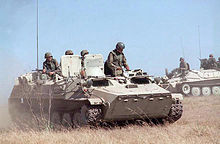Opposing Forces of the United States Armed Forces
As Opposing Force , or OPFOR , German enemy troops are called in the US armed forces , a military unit , the inside of maneuvers and other combat simulations, the enemy is ( enemy representation ). In order to achieve this as realistically as possible, they often use appropriate foreign weapons and equipment, or their own equipment based on the models through appropriate modifications. At the same time, they operate according to enemy tactics and operational doctrines in order to represent enemy troops within the military exercise for their own troops with the greatest possible authenticity.
Army
The US Army operates three central training and combat simulation facilities with appropriate training areas, which each combat unit passes through on a regular basis, but at least every two years. These facilities each accommodate an OPFOR unit permanently stationed there , whose task it is to test the units temporarily visiting there, to identify their weak points and to instruct them in enemy tactics or to take over the enemy representation in the maneuvers. Two of them are in CONUS ; Continental United States (on the North American continent), the third in the Federal Republic of Germany . These are:
Facilities and units
- The National Training Center (NTC) in Fort Irwin in the US state of California with the 11th Armored Cavalry Regiment ( Black Horses ; Rappen), one of only two independent conventional regiments of the Army .
- The Joint Readiness Training Center (JRTC) in Fort Polk , Louisiana with the 1st Battalion, 509th Parachute Infantry Regiment , 1st Battalion of the 509th Parachute Regiment ( Geronimos ).
- The Joint Multinational Readiness Center (JMRC) (the former Combat Maneuver Training Center ) in Hohenfels, Bavaria with 1st Battalion, 4th Infantry Regiment (Separate) , 1st Battalion of the 4th Independent Infantry Regiment ( Warriors ).
Changed simulation focus
Until 2003, the NTC and JMRC's OPFOR units usually simulated a Soviet mot. Rifle Regiment or Division. The NTC used tanks of the type M551 Sheridan to represent Soviet BMPs . Outwardly modified HMMWVs and M113 were also in use to simulate Soviet armored vehicles of the BRDM-2 type . M1 Abrams tanks with different paintwork and superstructures were also used for the T-80 display. Also M60A3 were rebuilt match for this task and used.
In the mid-1990s, Army units were trained in the JMRC for peacekeeping operations in the former Yugoslavia , in which the OPFOR units maneuvered into corresponding enemy formations. Troops were later trained for so-called counter-insurgency missions in Operation Iraqi Freedom and Operation Enduring Freedom .
In the spring of 2004, the focus began to focus on urban warfare training in preparation for operations in Afghanistan . In order to make these maneuvers as realistic as possible, entire villages were built on the training area and several hundred Arabic-speaking soldiers in appropriate national costumes were deployed as local civilians . The soldiers were made familiar with the cultural conditions of the target country in order to be able to establish contacts with as little conflict as possible.
Many US military establishments have their own units that fill the OPFOR role.
During the joint Crocodile '03 maneuver with Australia, Australian OPFOR units acted as enemy troops for units of the Marines .
Air Force

The US Air Force has been using the OPFOR concept since the 1970s. It operates so-called aggressor squadrons (aggressor squadrons ) that either use foreign aircraft types or their own, which correspond to or are similar to the respective performance characteristics. These are provided with hostile camouflage patterns and national emblems. The tactics and flight patterns are based as closely as possible on the role models. The adaptation went so far that at the time of the Cold War, Russian was spoken on radio between the individual machines.
In the US Navy , OPFOR units are known as Adversary Units.
USMC
In the US Marines , OPFOR units are called Adversary Units.
Web links
- Validating the "Enemy" ( Memento from February 18, 2007 in the Internet Archive )
- Images and information about VMFT-401's operations ( Memento from August 20, 2006 in the Internet Archive ) (English; PDF file; 1021 kB)
- Nellis AFB Aggressor Ops Agressor Squadrons (English)
Individual evidence
- ^ John Wellfare: Exercise Crocodile '03. You win some, you lose some. in: The Soldiers' Newspaper.
